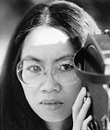
When the Eye Frames Red
Akira Mizuta Lippit--I want to begin by thanking you for agreeing to sit for this interview. It's perhaps worth noting that this interview is destined, at least in the first instance, for a Japanese audience and precedes the screening, in the near future, of your films at the ICC, which includes the Japanese premier of your 1985 film Naked Spaces, Living Is Round. There has been a vibrant interest in your films and written work in Japan, where you have recently spent some time, so perhaps we can touch upon those experiences and your reception there a little later.
It is in some ways an extremely difficult task to approach you for an interview. The conventions of this medium assume some notion of a constant or discernable identity, an interviewee whose essential features are either already known or can be known. In the case of Trinh T. Minh-ha, one recognizes a filmmaker and a scholar, but also an artist of many shades, a perpetual traveler, and a person whose own history in the world is marked by the epistemic shifts that characterize this century and its thought. Looking back on the various interviews collected in Framer Framed, I'm struck by the sheer diversity of subjects that you speak of, but also by the sometimes anxious ways in which the interviewer tries, at times, to situate you within established traditions of experimental filmmaking, the critique of anthropology and conventional documentary, ethnography, poetics, post-colonial thought, feminist thought and activity and so forth. I'll try to resist the temptation to identify, as it were, a fixed dwelling and try instead to follow the nomadic qualities of your expansive work.
Since many of your previous interviews speak to your cultural politics and positions vis-a-vis the subject of alterity, I thought we might approach this conversation from the vantage of your films, which represent, in my opinion, absolutely discrete and distinct pieces of work, which are nonetheless bound by a very particular spirit or desire. So, perhaps to begin with this notion of a project, how do you define your film project-if you accept the notion of a project-and how does your film work fit into your broader artistic and intellectual projects?
Trinh T. Minh-ha--When I work on a film, I am drawn very intensely to the world of images and sounds. On a basic level, such a state of creative availability and of active receptivity is in itself a "project."
But the making of a film also opens up many doors to other means of creativity. It sharpens the edge between, let's say, writing for a book and writing for a film-a difference one constantly faces when words are part of the film fabric.
Not only does the use of language differ markedly from one medium to another, but working with storytelling, poetry and everyday speech in cinema also makes me aware of music in ways I never thought of before. If a poem is an invisible painting, as Chinese artists put it, then a film can be all at once visible poetry, musical painting and pictorial music. The spaces between image, sound and text remain spaces of generative multiplicity, in which the function of each is not to serve nor to rule over the other, but to expose, in their tight interactions, each other's limit. What I cannot avoid experiencing at certain moments of the process is both the different strengths and limits of these tools of creativity.
So it is in working constantly with these limits and with the circumstances that define them that I advance, quite blindly, actually. Even though in discussions, it does seem as if all my projects are very lucidly thought out, this comes in the making process, not before it. Most of the time I jump into a project blindly, and this is how boundaries are also displaced.
Lippit--So you see the production of a film as something that opens up a space for writing, thinking, and learning, even as you are creating the work itself?
Trinh--Yes, very strongly. There's a whole web of activities involved in and triggered by the making of cinematic images. I have no such thing as a preconceived idea that I want to visualize or illustrate through film. It doesn't happen that way; it's more likely through an encounter-with a person, with a group of people, with an event, or with a current of energy that is sparked by a specific situation.

 Next
Next